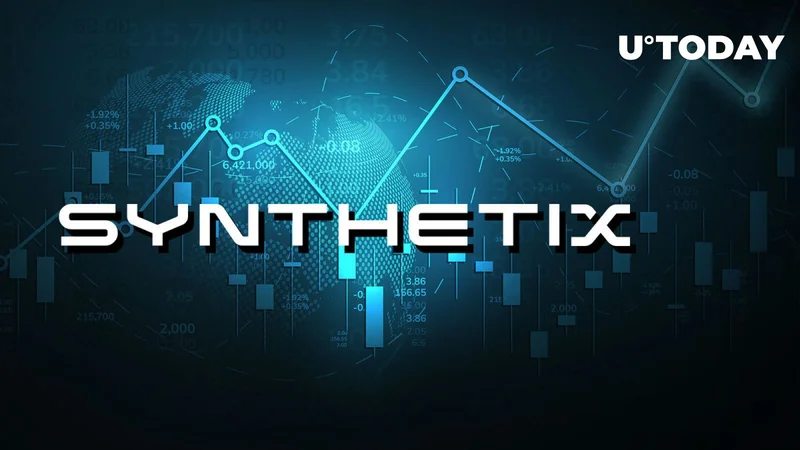Article Directory
It’s easy to get lost in the noise. I see it every day. The crypto world is a chaotic symphony of price charts flashing red and green, breathless predictions of a "100x pump," and the inevitable fear when a stablecoin… isn't stable. Looking at Synthetix (SNX) right now, you could be forgiven for getting whiplash. One headline screams about a macro breakout to $12, while another dissects the painful de-pegging of its sUSD stablecoin.
But if you only focus on that, you’re missing the real story. You’re watching the waves on the surface while a tectonic shift is happening on the ocean floor.
What I'm seeing in Synthetix isn't just the volatile life cycle of another crypto asset. It's a profound, deliberate metamorphosis. We are witnessing a DeFi "OG"—one of the original, foundational projects—shedding its experimental skin and forging itself into something far more ambitious: a core piece of the future financial system. This isn't about the price next week. This is about the architecture of the next decade.
When I first read the Synthetix Proposal to End Inflation: Reshaping SNX stakers’ equity may become a deflationary blue-chip project, I honestly just sat back in my chair, speechless. This is the kind of move that signals a project is graduating. It’s moving out of its parents' basement, so to speak, and into the real world. For years, DeFi projects have relied on inflationary rewards—basically, printing more of their own token—to attract users and liquidity. It’s a powerful tool for kickstarting a network, a necessary booster rocket to escape Earth's gravity. But it’s not a sustainable flight plan.
Now, Synthetix is preparing to shut off that booster. The proposal to end inflation and potentially use 50% of the fees generated on its new Base deployment to buy back and destroy SNX is a complete paradigm shift. Let’s break that down with a simple self-correction here: inflation devalues everyone’s holdings by creating more supply, while deflation—which is what a buy-and-burn mechanism creates—makes the remaining tokens more scarce and, theoretically, more valuable. This is a pivot from a "growth-at-all-costs" startup mentality to a "sustainable, profitable enterprise" model. It’s a declaration of confidence. It says, "Our system is now powerful enough to sustain itself on the real value it creates, not on token incentives."
What kind of system could possibly justify that confidence? And is this just a desperate gamble or a calculated, strategic evolution?

Forging a New Financial Superhighway
The answer lies in what this new, non-inflationary engine is being built to power. Synthetix is on the verge of launching a fully decentralized perpetuals exchange (DEX) directly on the Ethereum mainnet. This isn't just another trading venue; it's an attempt to solve one of the fundamental trilemmas of DeFi: how to get the security of Ethereum without the crippling gas fees.
Their solution is a hybrid on-chain/off-chain architecture. Imagine it like this: You place your trade order instantly and without a gas fee, as if you were on a centralized exchange like Binance. That order is matched with others in a high-speed, off-chain environment. But the final settlement, the actual transfer of value, happens securely on the Ethereum blockchain. You get the best of both worlds—it's a system designed for institutional-grade performance but with the accessibility of a retail app and it all settles right on Ethereum's mainnet without crazy gas fees—this is the kind of elegant solution we've been dreaming about for years.
This isn’t just an upgrade; it’s a historical analogy in the making. It reminds me of the shift from local, fragmented marketplaces to the construction of the first national railway systems. Suddenly, goods could move faster, cheaper, and more reliably across vast distances, unlocking a new era of commerce. That's what Synthetix is aiming for with this DEX—a frictionless superhighway for decentralized derivatives trading.
Of course, building something this revolutionary is messy. And right now, we’re seeing the mess. The sUSD stablecoin de-pegging is a serious, painful problem for its holders. The founder’s "no crying in the stablecoin casino" comment, while perhaps brutally honest about the risks of the frontier, highlights the immense pressure. But I don't see this as a fatal flaw. I see it as a system groaning under the weight of its own ambition. The old infrastructure, built for a different purpose, is being stress-tested to its breaking point by the demands of the new one.
It’s forcing the hard questions. How do you ensure rock-solid stability for a system designed to handle billions in daily volume? The pain of the de-peg is a crucible, forcing the developers and the community to forge a more resilient foundation before the floodgates of the new DEX are opened. It’s a harsh, but perhaps necessary, trial by fire. This brings us to a crucial moment of ethical consideration: as these platforms evolve from niche experiments into global infrastructure, the responsibility to protect users from systemic risks becomes paramount. The cavalier attitude of the early days has to mature along with the technology.
So while the market panics over a broken peg or gets euphoric about a potential price pump, the real work is being done on the foundational level. The economic model is being hardened. The core infrastructure is being rebuilt for a new scale of ambition. This is the unglamorous, difficult, and absolutely essential work of turning a brilliant idea into a world-changing reality.
The Blueprint is Becoming Reality
When you strip away the daily noise, a clear picture emerges. Synthetix is executing a multi-year pivot from an inflationary, experimental protocol into a deflationary, high-performance financial primitive. The price charts don’t show you the architectural elegance of a hybrid DEX. The daily sentiment doesn’t capture the long-term economic impact of ending inflation. We are watching a team make the difficult, strategic decisions required to build something that lasts. The journey is volatile and, for some, painful. But this is what building the future actually looks like—it’s messy, it’s ambitious, and it’s happening right now.




